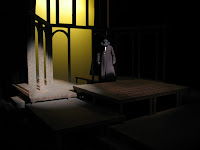 Mortal: Hmm…
Mortal: Hmm…[There are a pair of soft poofs and a man in 19th-century clothing appears on one of the mortal’s shoulders, and a man in 18th-century clothing on the other.]
Kant: You weren’t about to steal paper out of that printer, were you?
Bentham: Well, hurry up and get on with it.
Mortal: Hey, what happened to the angel and demon?
Bentham: They’re on vacation. We’ll take it from here.
Kant: And I’m going to tell you not to steal paper from out of the printers in the library.
Bentham: Oh, come on, Immanuel. The cost to the college is negligible. Paper is what, a fraction of a cent a sheet? Meanwhile the benefit to this mortal here is quite real and immediate.
Mortal: I need to put a sign up about my lost bike.
Bentham: Overall, there’s more good being done than harm.
Kant: [crosses his arms belligerently] Yeah, and what if everybody stole paper from the printer? The college’s paper budget would go up, and they would have to scrimp on other supplies, or raise tuition for the students. That doesn’t sound so harmless.
Mortal: Jeez, you sound like my mother.
Bentham: If they raised tuition, the students would essentially be paying for the paper they took, making the decision morally neutral.
Kant: Utilitarian claptrap.
Bentham: You’d have people do things that are stupid and wrong just to conform to some … general principle! ‘Always tell the truth.’ What if your dear, aged Aunt Ethel wants to know what you thought of that magenta-and-orange sweater she sent you, eh? EH?
Mortal: Guys, guys–
Marx: The paper supply should be socialized.
Kant: Oh, hey, Karl. Long time no see.
Marx: Well, it’s been kind of rough since 1989.
Mortal: What the hell is going on here? I just want my paper.
Marx: If, after long and bloody class warfare, you made the paper publicly available, the people could take paper each according to their needs, and everybody would be happy.
Bentham: [whispers] I told you he was nuts.
Mortal: That doesn’t exactly help with my immediate problem.
Marx: What do I care about your immediate problem? Workers of the world unite!
Kant: Meanwhile, Jeremy, you seem to have the misguided impression that–
Plato: That paper is but a mere shadow of the true Form of Paperness.
Neo: I’ll second that. Wait – what?
Mortal: Guys–
Simpson: Where’s the donuts?
Bentham: Dude, wrong Homer.
Mortal: Guys–
Nietzsche: This conversation is meaningless.
Kierkegaard: You’re all a bunch of idiots!
Mortal: Aaaaaaah!
[The philosophers fall silent for a moment.]
Bentham: Well, looks like we drove another one around the bend.
Kant: [high-fives him] Nice work!






 It’s an old show, yes, but I was only introduced to it the other day. Some sci-fi house friends have the show on DVD and they’ve been playing it on the house TV. Fascinating. First of all, it’s got way better developed characters than the original Star Trek. But what prompted me to blog about it is the way they get the most bang out of their cheap-o special effects.
It’s an old show, yes, but I was only introduced to it the other day. Some sci-fi house friends have the show on DVD and they’ve been playing it on the house TV. Fascinating. First of all, it’s got way better developed characters than the original Star Trek. But what prompted me to blog about it is the way they get the most bang out of their cheap-o special effects.